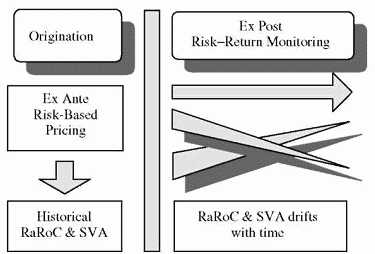RISK-BASED PRICING
Category: Risk Management in Banking
A direct application of RaRoC and SVA is to determine the appropriate customer price given risk. The approach is identical to the one used to derive price from a target Return On Equity (ROE) applied to the regulatory capital. The only difference is that economic capital replaces regulatory capital. Instead of moving down from revenues to RaRoC and SVA, we move bottom-up, from target return to target pricing.
The Customer Rate
The example in Table 54.4 shows the difference in target prices obtained with regulatory capital and economic capital. Regulatory capital does not differentiate price with risks when two private counterparties belong to different risk classes. Economic capital does.
The example uses an exposure net of recoveries of 100, with a 100% weight for the Cooke ratio, a cost of debt of 10%, and operating costs equal to 2% of exposure. The target customer rate covers the cost of debt and operating expenses, and provides a return on capital of 20% before tax (hurdle rate).
The calculation of the target customer rate consists of adding the risk premium, as detailed above, to the cost items. The premium collapses to zero when there is no risk, and increases proportionally with capital.
The price is the same for both transactions with regulatory capital. When using economic capital, it increases with risk, due to the risk premium included in the cost of capital. The relationship between risk and price is straightforward. Whenever there is credit risk, the price increases proportionally with the risk premium. In the absence of risk, the (risk-free) price should only cover the cost of debt plus operating costs.
Origination and Post-origination Follow-up
For reporting purposes, the profitability ratios are historical, with values at origination. Moreover, RaRoC and SVA differ at origination and after, because both risks and valuation change when time drifts. Recalculating the RaRoC and SVA of a given facility post-origination would therefore result in values differing from the historical values at the origination date. In other words, RaRoC and SVA measures differ at origination and post-origination and drift with time. The variation results from the normal drift of risk through
FIGURE 54.1 Ex ante versus ex post risk-reward profiles
time, since risk decreases when residual maturity declines, even if periodical revenues are constant (under constant valuation of exposure1) (Figure 54.1).
Post-origination, we know the actual revenues and risk migrations. Hence, periodical recalculations of RaRoC and SVA would result in different values, so that the risk-adjusted performance of the same transaction will drift with time. Ex post risk-return monitoring implies updates as time passes to get the risk-return profile of the portfolio, take corrective action or enter into more active portfolio management. RaRoC and SVA ex post measures allow us to decide whether there is an economic rationale to keep a transaction in the portfolio. If the RaRoC deteriorates because of credit events, there is an incentive to off-load the risk before it decreases further and ultimately defaults. Therefore, there is a rationale for using RaRoC and SVA in ex post reports, to periodically recalculate their values and keep a track record of these values. There is also a case for keeping track of RaRoC and SVA values at origination, and for controlling ex post drifts.


